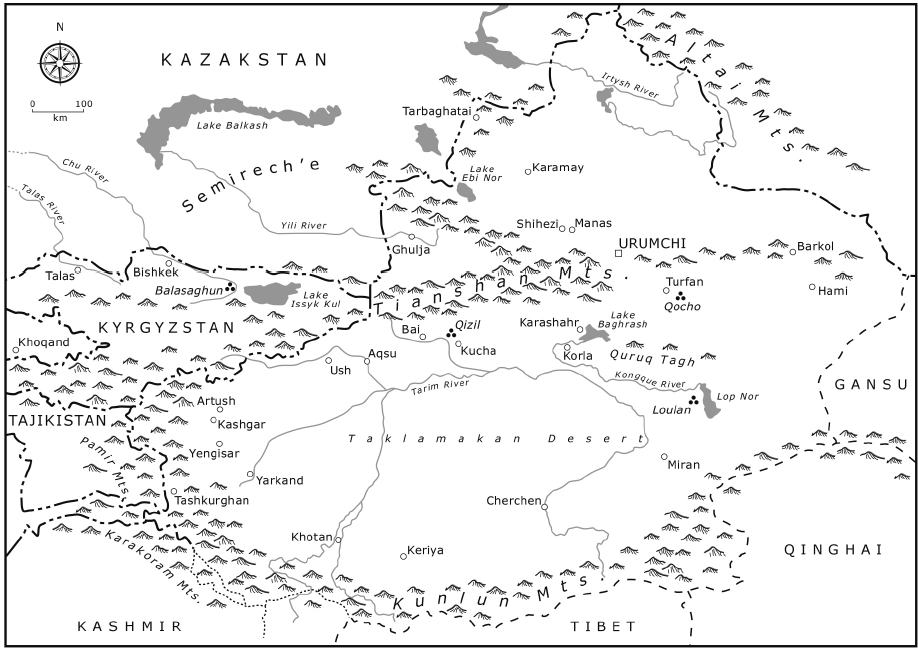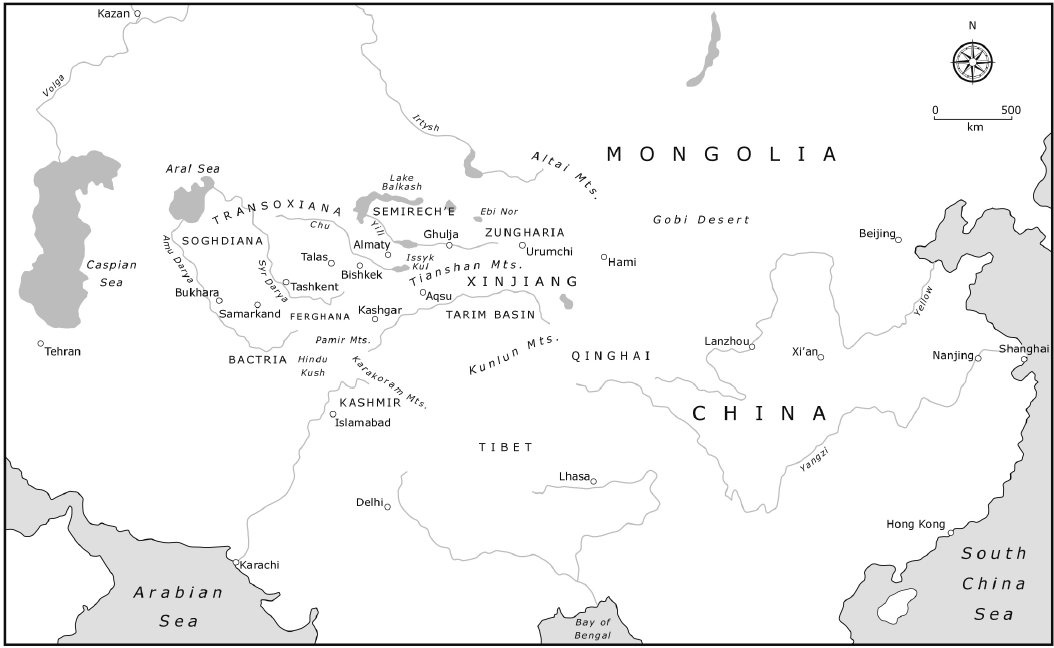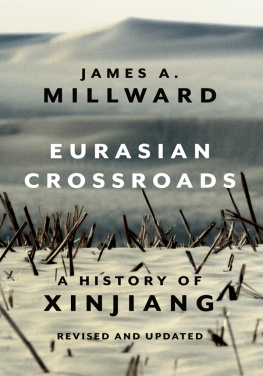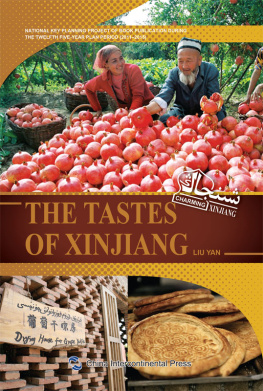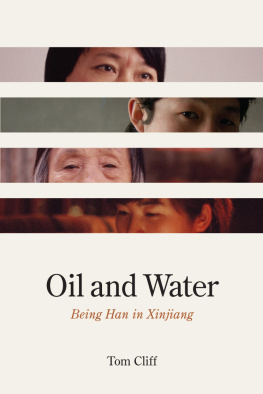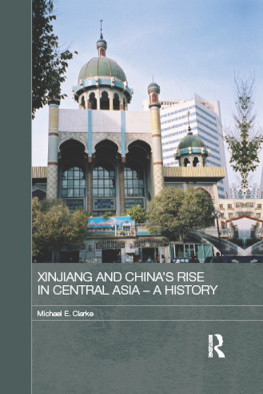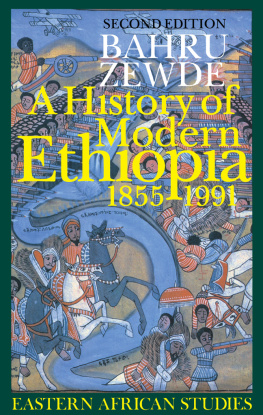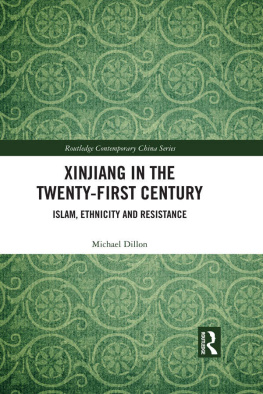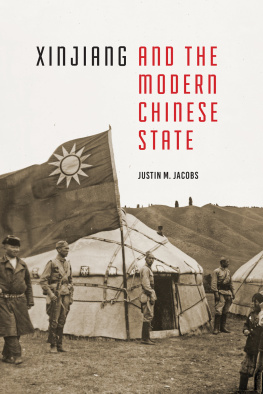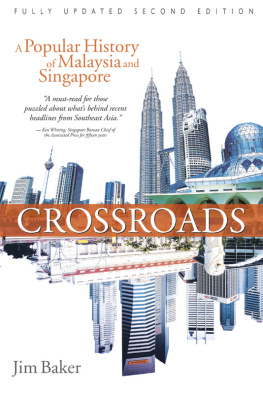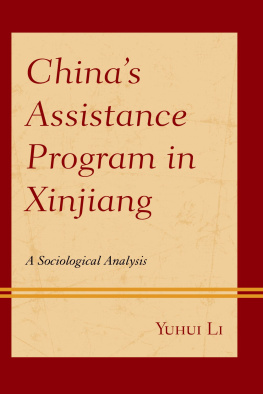Table of Contents
EURASIAN CROSSROADS
JAMES A. MILLWARD
Eurasian Crossroads
A History of Xinjiang
Revised and Updated Edition
Columbia University Press New York
Columbia University Press
Publishers Since 1893
New York Chichester, West Sussex
cup.columbia.edu
Copyright 2022 James A. Millward
All rights reserved
EISBN 978-0-231-55559-3
First published in the United Kingdom in 2007 by
C. Hurst & Co. (Publishers) Ltd.,
41 Great Russell Street, London, WC1B 3PL
This revised and updated paperback edition first published in 2021
James A. Millward, 2021
Library of Congress Cataloging-in-Publication Data
Names: Millward, James A., 1961- author.
Title: Eurasian crossroads: a history of Xinjiang / James A. Millward.
Other titles: History of Xinjiang
Description: Revised and updated. | New York: Columbia University Press,
[2021] | First published in the United Kingdom in 2007 by C. Hurst & Co.
(Publishers) Ltd. | Includes bibliographical references and index.
Identifiers: LCCN 2021017735 (print) | LCCN 2021017736 (ebook) |
ISBN 9780231204545 (hardback) | ISBN 9780231204552 (trade paperback) |
ISBN 9780231555593 (ebook)
Subjects: LCSH: Xinjiang Uygur Zizhiqu (China)History.
Classification: LCC DS793.S62 M537 2021(print) | LCC DS793.S62(ebook) |
DDC 951/.6dc23
LC record available at https://lccn.loc.gov/2021017735
LC ebook record available at https://lccn.loc.gov/2021017736
A Columbia University Press E-book.
CUP would be pleased to hear about your reading experience with this e-book at .
Cover design: Gavin Morris
Contents
Map 1: The Xinjiang Region
Map 2: Xinjiang, China and Central Eurasia
This book is a survey history of a region at the centre of Eurasia. Now known as Xinjiang (pronounced Hsin-jeeang), this area has been known by many names in the past. One of those old names, Chinese Turkestan, might well have served as this books title. Turkestan was a term medieval Islamic writers applied to the northern and eastern parts of Central Asiathe lands of the Turkic-speaking nomads, as opposed to the Persian-speaking dwellers in the oases. Marco Polo also used this name. When Tsarist forces conquered Central Asia in the nineteenth century they followed suit, calling their new imperial acquisition Turkestan. Logically enough, European writers around the same time began to refer to those parts of Central Asia further east, those under the control of the Qing dynasty, as Chinese Turkestan, distinguishing it from Russian Turkestan.
Though old, the term Chinese Turkestan retains a certain relevance. Xinjiang has for a millenium and a half been a land of Turkic-speaking peoples, now represented by Kazakhs, Kirghiz, and mainly the Uyghurs, who comprise the bulk of the non-Han Chinese population in the region. On the other hand, Xinjiangas opposed to parts of Central Eurasia lying west of the Pamirshas also long had close contacts with China, and for most of the time since the mid-eighteenth century it has lain under the control of Beijing. In this way, Xinjiang is indeed both Turkic and Chinese.
However, the term Chinese Turkestan is controversial. Although the Peoples Republic of China (PRC) frequently refers to Chinas Tibetand even publishes an English-language propaganda magazine under that titleany reference to Turkestan evokes the two short-lived Eastern Turkestan Republics of the 1930s and 1940s, as well as the names of more recent Uyghur separatist groups. Since the PRC officially maintains that Xinjiang has been part of China since the first century BCE, any allusion to the regions other past political and ethnic identities is unwelcome. It is the eighteenth-century term Xinjiang by which the PRC and the rest of the world now refers to the area; the term Turkestan only appears in China if carefully quarantined in quotation marks and attributed to Western colonialists or contemporary terrorists.
On the other hand, Uyghur nationalists, who consider the Xinjiang region their own homeland unjustly invaded and conquered by China, likewise have little use for the label Chinese Turkestan, though for opposite reasons: the term codifies the regions modern Chineseness.
The name Chinese Turkestan thus reflects a key characteristic of the regions historyits ethnic diversity and situation at the overlap of cultural realmsand crystallises the problem of reconciling ethnic and political identities, a problem that has troubled this continental crossroads for most of the past century.
I am neither a Chinese nationalist nor a Turkic nationalist (rather, I like to consider myself a friend of both Han and Uyghur peoples and, more generally, of China). Still, no student of the regions history can escape the politics that suffuses Xinjiang studies today. It pervades the secondary literature, be it PRC publications or Uyghur websites. Scrutiny from Beijing forces even non-Chinese scholars to think and rethink what they write and say in public settings. (The draft of a recent volume of collected articles about Xinjiang by Western scholars was smuggled to China, translated, circulated, and rebutted internally in the PRC before it had even been published in the United States.) US military expansion into Central Asia, the casting of Xinjiang tensions as part of the global war on terror, and the incarceration of Uyghurs in the US prison camp and off-the-books legal purgatory at Guantanamo means that Washington too has a growing interest in the Uyghurs and Xinjiangan interest that makes the PRC in turn suspicious. Any effort to sort out the history of the Xinjiang region is complicated by these political concerns. Moreover, besides the rival primordialist claims on the regionis the region Chinese since ancient times, Uyghur since ancient times, or something else?there are other issues with contemporary implications. What has been the role and nature of Islam in the area? What are the benefits and drawbacks of Xinjiangs twentieth-century development and globalisation? How have Uyghurs and other minority peoples in the PRC fared under the policies of the Chinese Communist Party? Is Uyghur dissent tied to international Islamist terror networks?
Although I address these and similar fraught questions in the following pages, the goal of this book is not to weigh in on the political issues besetting Xinjiang today. Rather, I hope to provide an overview to the history of a region that has played an important role in world history, but for which there is no good introduction in English. Xinjiang, as the hub of the Silk Road and point of contact of various Eurasian peoples and cultures, has long fascinated readers for its diversity and exoticism. But for precisely these reasons, the sources for the study of the regions history are challenging, requiring specialised knowledge and access to materials ranging from artefacts unearthed in the desert and paintings daubed on the walls of caves, to texts in Tokharian, Trk, Soghdian, Tibetan, Mongolian, Manchu, classical Chinese, Chaghatai and Persian, not to mention important secondary works in Chinese, Russian, Japanese, French, Turkish, German and other modern languages. These materials are scattered in libraries and museums across the globe. Moreover, Xinjiang has in one way or another been part of the histories of the Tibetan, Arab, Turkic, Mongol, Russian as well as Chinese empires, so its historiography involves place names and personal names in multiple languages. Specialists in one of these historiographies may well struggle with terms from another.


